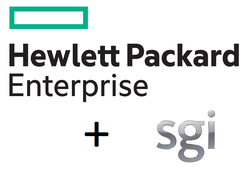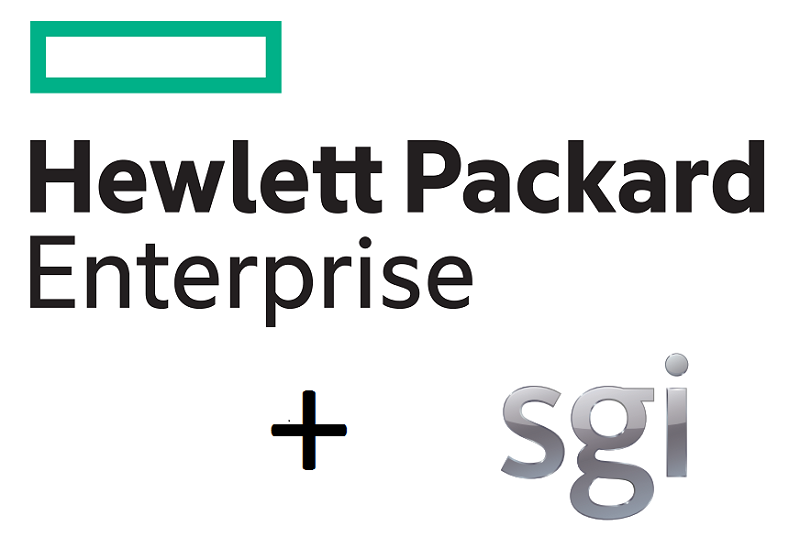
Aug. 11, 2016
By: Michael Feldman
HPE has signed an agreement to acquire SGI for $275 million, a deal that will bring together two of the top HPC system vendors under a single corporate master. Assuming the bid clears regulatory hurdles, the acquisition will represent the largest realignment of the HPC server space since IBM sold its x86 server business to Lenovo in 2014.
 A Silicon Valley icon, SGI has endured a turbulent history. Founded in 1981, SGI was initially known for its high-end graphic workstations, but later moved into the server space via the high performance computing market. In 1996 the company acquired Cray Research, which in 2000 was sold to Tera Computer Company, later to become Cray Inc. In its heyday in 1997, SGI posted an annual revenue of 3.7 billion, but struggled to make a profit. That unfortunately became a habit the company could never shake.
A Silicon Valley icon, SGI has endured a turbulent history. Founded in 1981, SGI was initially known for its high-end graphic workstations, but later moved into the server space via the high performance computing market. In 1996 the company acquired Cray Research, which in 2000 was sold to Tera Computer Company, later to become Cray Inc. In its heyday in 1997, SGI posted an annual revenue of 3.7 billion, but struggled to make a profit. That unfortunately became a habit the company could never shake.
SGI financial challenges continued after 2000, and in 2006 the company declared bankruptcy, re-emerging after several months, and issuing new stock. In 2009, it declared bankruptcy again, this time selling most of its assets to Rackable Systems. In what turned out to be a bad omen, Rackable adopted the name of its ill-fated acquisition. Since the Rackable deal, the born-again SGI has not delivered a profitable 12 months from a GAAP standpoint. Over the past three years (FY14-FY16), it has posted net losses of $53 million, $39 million, and $11 million, respectively.
So why was HPE compelled to buy it? According to their press release, “HPE's acquisition of SGI will strengthens its position in the $11 billion high-performance computing (HPC) segment which is growing at an estimated 6-8% CAGR, and in the data analytics segment, which is growing at over twice that rate.”
That certainly makes some sense. The overall server space, where HPE leads its competitors, is not growing as consistently or as robustly as the HPC and data analytics sub-segments. The hyperscale server space certainly has attractive growth rates, but much of that market has foresaken OEMs like HPE and Dell, and turned to low-margin ODMs such a Quanta and Wistron.
As far as the high performance computing market goes, HPE already enjoys an enviable position. According to the latest (2015) figures from HPC market research specialist Intersect360 Research, HPE is the number one system provider in this space with a 28 percent market share; SGI is in sixth place with a 3 percent share. Intersect360 Research CEO Addison Snell says he would "expect HPE’s share to go up again in 2016, because IBM seems to have had some x86 revenue share left in 2015, even though the deal closed after Q3 2014."
Going forward, HPE could certainly fold in SGI’s market share, but the current product sets are unlikely to survive intact given the significant overlap across the two companies. In particular, SGI’s scale-out ICE and InfiniteData clusters have their counterparts in HPE’s Apollo lineup. Although the underlying designs are somewhat different, both are x86-based InfiniBand/Omni-Path machines aimed at mainstream HPC and big data users. Their biggest difference is in their cooling design, but that’s hardly enough of a differentiator to warrant separate product development and marketing budgets. As a result, it’s hard to imagine both portfolios moving forward in parallel under the HPE banner.
SGI’s scale-up UV line is a more unique offering in that it includes a custom interconnect as the basis for its shared memory SMP architecture. It’s designed for in-memory databases, like SAP HANA, which need more memory and sockets per node than can be had in a traditional dual-socket server setup. But even here, there’s notable overlap with HPE’s Superdome X platform, a system that can scale up to 16 sockets and 24 TB of memory and is aimed at the same in-memory database application set.
In this case though, SGI’s UV design offers a lot more scalability -- up to 256 sockets and 64 TB of memory – and offers a special use case as a fat node add-on in traditional HPC clusters. Also, unlike the Superdome, the UV is not built for mission-critical work. So here it’s conceivable that the UV line will continue its run, perhaps under new branding. At some point though, a merging of the architectures seems likely.
The storage products for the two companies is more diverse. SGI’s offerings include its InfiniteStorage line, Lustre and CFXS file system products, and DMF tiered data management software, all aimed at the HPC and big data markets. HPE sells its 3PAR StoreServ for mainstream enterprise storage, a StoreVirtual product as a software defined/virtualized solution, and the XP Storage line for mission-critical applications. Here there is bound to be some consolidation on the hardware side, but SGI’s storage software should fare much better.
In fact, SGI’s software in general, as well as the application expertise that underlies it, should prove of particular value to HPE, especially in its HPC ambitions. Besides things like Lustre, SGI also has software offerings in areas such as MPI libraries and performance tools. In addition, it offers a remote 3D visualization product (VizServer) that supports GPU virtualization. Other areas of software expertise include integration and optimization of computational fluid dynamics (CFD), computations electromagnetics (CEM), and computational structural mechanics (CSM) packages. SGI’s extensive application legacy in areas such as government, academia, oil & gas, manufacturing, and earth sciences dovetails nicely with HPE’s strengths in financial services and other business-centric domains.
Is all that worth $275 million? Time will tell. HPE expects the acquisition to be earnings-neutral in the first year, after which they hope to start building additional value. The deal is expected to close in the first quarter of HPE’s fiscal year 2017.
